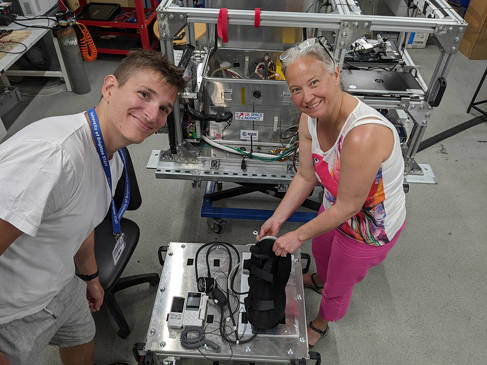UK (University of Brighton) Flying high: Brighton researchers take to zero gravity to improve lower limb wound treatment in space

Led by Rachel Forss from the School of Sport and Health Sciences and the Centre of Regenerative Medicines and Devices at the University of Brighton, the research team will conduct experiments on a parabolic flight in April 2024 from the Novespace centre in Bordeaux to assess how weightlessness impacts the circulation to the lower leg. Funded by the UK Space Agency, not only will the insights gleaned be useful for space missions and those who experience hyper gravity conditions – but the kit is poised to improve the efficiency of lower limb assessments for patients being examined in healthcare settings.

Rachel Forss (project lead) and Dr Marco Bernagozzi inspect the kit to be used on the upcoming parabolic flight
Systems which can assist in the rapid assessment and diagnosis of circulatory problems are vital. Peripheral arterial disease happens when the blood vessels carrying blood to the legs and feet become narrowed or blocked. It becomes more common with age and when individuals have a number of conditions, affecting about 1 in 5 people aged over 60. As the current population is ageing and life expectancy increases, chronic wounds are becoming more common and costly to health services worldwide, as well as negatively impacting the quality of life of patients. Identifying and referring people with this condition as quickly as possible is essential.
In a routine assessment, different measurements are taken to build up a picture of how circulation is behaving. This project seeks to develop an assessment station that will enable five measurements to be captured simultaneously – toe pressures, capillary bed oxygen saturation, arterial oximetry, heart rate and lower extremity temperatures – and therefore, significantly improve vascular assessments in terms of efficiency and information gleaned.
Researchers will evaluate the arterial and capillary status of participants thoroughly and investigate how circulation fluctuates in normal gravity situations. Then, researchers will board the parabolic space flight where weightless conditions similar to outer space are created and test the same equipment to see if there are circulatory changes which occur in lower limbs when exposed to near zero-gravity and hyper gravity conditions.
As gravity normally ‘pulls’ blood to the lower extremities and increases blood volume in the core of the individual, it will be crucial to determine how this affects lower limb tissue and, potentially, tissue healing. As space travel and long-range missions are being developed, more knowledge on body system behaviour under these micro- and hyper conditions needs to be gained to maintain the health and healing ability of astronauts and could have implications for others exposed to strong gravitational force, including fighter pilots and racing car drivers.
Project lead Rachel Forss said:“This is a really exciting opportunity to explore if there are detectable changes in the peripheral circulation of individuals while experiencing different gravitational conditions whilst on a parabolic flight. This information will help us to identify which pieces of equipment work best in this environment and then to enable future project designs to see if we can evaluate how circulation is affected.”
The research project will run from June 2023 for 12 months and builds on previous grant wins demonstrating trailblazing, interdisciplinary expertise in the area of wound healing in both space and ground applications and combining engineering, health and applied science specialties.
